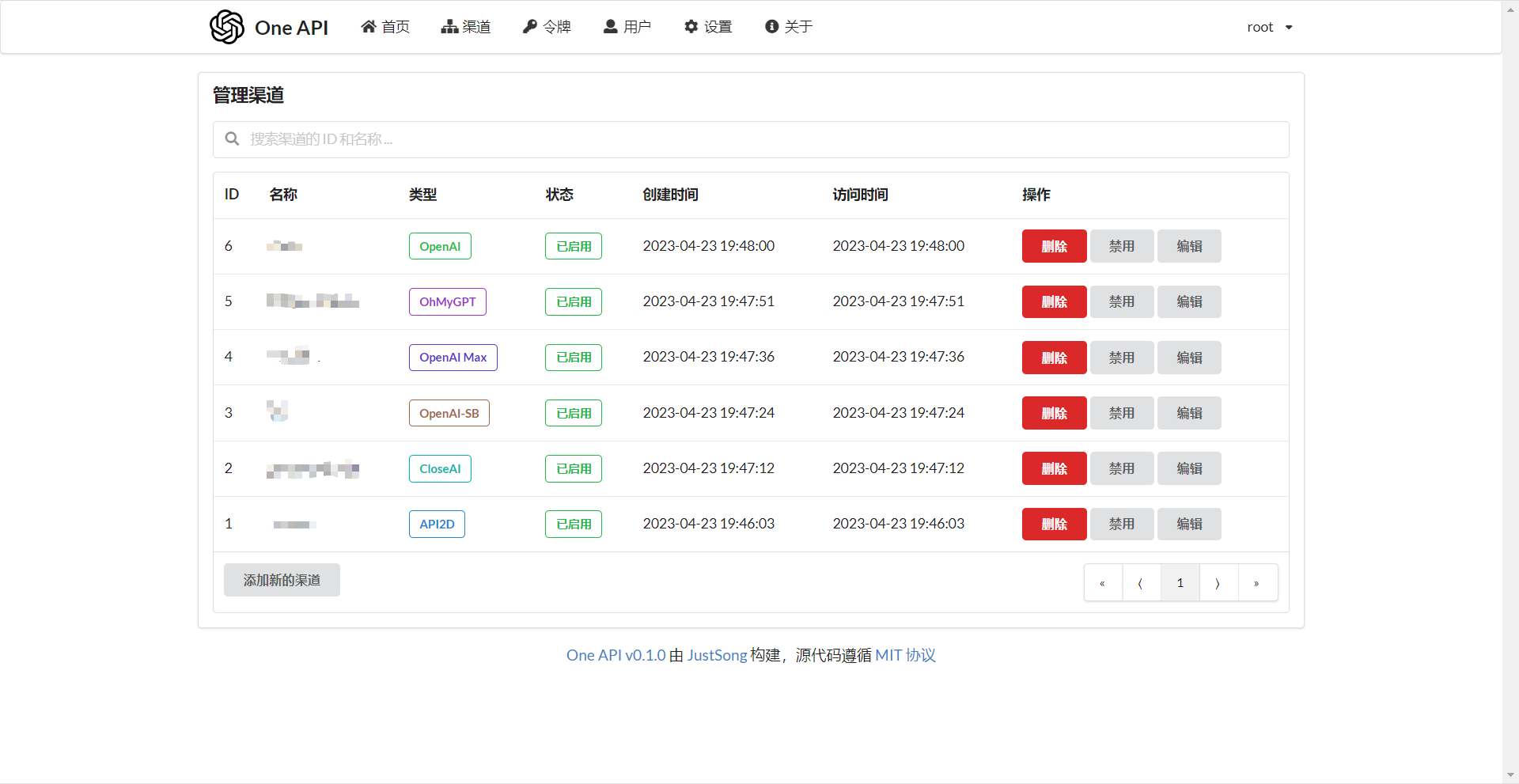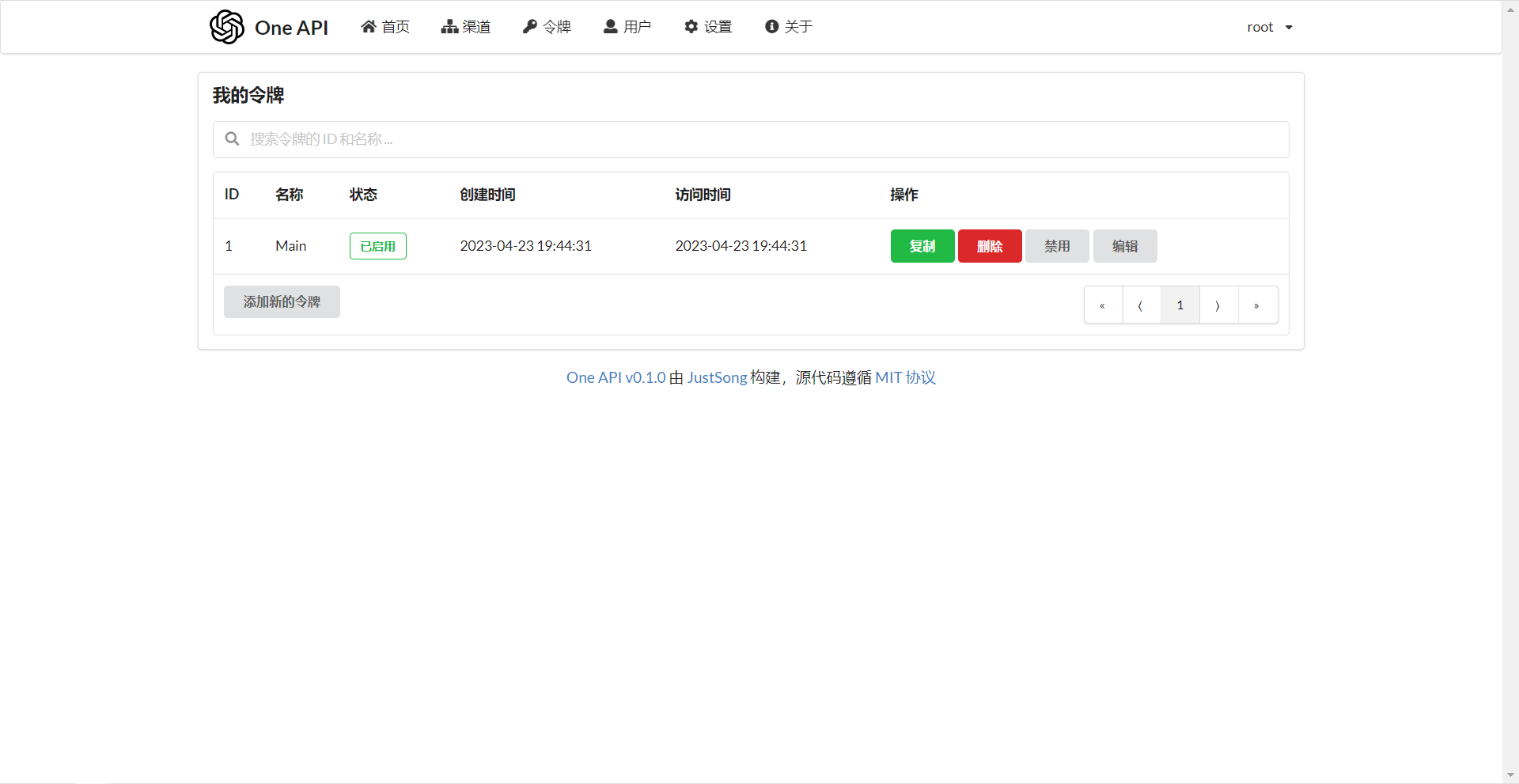Deployment Tutorial · Usage · Feedback · Screenshots · Live Demo · FAQ · Related Projects · Donate
Warning: This README is translated by ChatGPT. Please feel free to submit a PR if you find any translation errors.
Warning: The Docker image for English version is
justsong/one-api-en.
Note: The latest image pulled from Docker may be an
alpharelease. Specify the version manually if you require stability.
Deployment command: docker run --name one-api -d --restart always -p 3000:3000 -e TZ=Asia/Shanghai -v /home/ubuntu/data/one-api:/data justsong/one-api-en
Update command: docker run --rm -v /var/run/docker.sock:/var/run/docker.sock containrrr/watchtower -cR
The first 3000 in -p 3000:3000 is the port of the host, which can be modified as needed.
Data will be saved in the /home/ubuntu/data/one-api directory on the host. Ensure that the directory exists and has write permissions, or change it to a suitable directory.
Nginx reference configuration:
server{
server_name openai.justsong.cn; # Modify your domain name accordingly
location / {
client_max_body_size 64m;
proxy_http_version 1.1;
proxy_pass http://localhost:3000; # Modify your port accordingly
proxy_set_header Host $host;
proxy_set_header X-Forwarded-For $remote_addr;
proxy_cache_bypass $http_upgrade;
proxy_set_header Accept-Encoding gzip;
}
}
Next, configure HTTPS with Let's Encrypt certbot:
# Install certbot on Ubuntu:
sudo snap install --classic certbot
sudo ln -s /snap/bin/certbot /usr/bin/certbot
# Generate certificates & modify Nginx configuration
sudo certbot --nginx
# Follow the prompts
# Restart Nginx
sudo service nginx restart
The initial account username is root and password is 123456.
git clone https://github.com/songquanpeng/one-api.git
# Build the frontend
cd one-api/web/default
npm install
npm run build
# Build the backend
cd ../..
go mod download
go build -ldflags "-s -w" -o one-api
chmod u+x one-api
./one-api --port 3000 --log-dir ./logs
root and password is 123456.For more detailed deployment tutorials, please refer to this page.
SESSION_SECRET for all servers.SQL_DSN and use MySQL instead of SQLite. All servers should connect to the same database.NODE_TYPE for all non-master nodes to slave.SYNC_FREQUENCY for servers to periodically sync configurations from the database.FRONTEND_BASE_URL to redirect page requests to the master server.REDIS_CONN_STRING so that the database can be accessed with zero latency when the cache has not expired.SYNC_FREQUENCY must be set to periodically sync configurations from the database.Please refer to the environment variables section for details on using environment variables.
Refer to #175 for detailed instructions.
If you encounter a blank page after deployment, refer to #97 for possible solutions.
Zeabur's servers are located overseas, automatically solving network issues, and the free quota is sufficient for personal usage.
create database `one-api` to create the database.PORT with a value of 3000, and then add a SQL_DSN with a value of <username>:<password>@tcp(<addr>:<port>)/one-api. Save the changes. Please note that if SQL_DSN is not set, data will not be persisted, and the data will be lost after redeployment.The system is ready to use out of the box.
You can configure it by setting environment variables or command line parameters.
After the system starts, log in as the root user to further configure the system.
Add your API Key on the Channels page, and then add an access token on the Tokens page.
You can then use your access token to access One API. The usage is consistent with the OpenAI API.
In places where the OpenAI API is used, remember to set the API Base to your One API deployment address, for example: https://openai.justsong.cn. The API Key should be the token generated in One API.
Note that the specific API Base format depends on the client you are using.
To specify which channel to use for the current request, you can add the channel ID after the token, for example: Authorization: Bearer ONE_API_KEY-CHANNEL_ID.
Note that the token needs to be created by an administrator to specify the channel ID.
If the channel ID is not provided, load balancing will be used to distribute the requests to multiple channels.
REDIS_CONN_STRING: When set, Redis will be used as the storage for request rate limiting instead of memory.
REDIS_CONN_STRING=redis://default:redispw@localhost:49153
SESSION_SECRET: When set, a fixed session key will be used to ensure that cookies of logged-in users are still valid after the system restarts.
SESSION_SECRET=random_string
SQL_DSN: When set, the specified database will be used instead of SQLite. Please use MySQL version 8.0.
SQL_DSN=root:123456@tcp(localhost:3306)/oneapi
LOG_SQL_DSN: When set, a separate database will be used for the logs table; please use MySQL or PostgreSQL.
LOG_SQL_DSN=root:123456@tcp(localhost:3306)/oneapi-logs
FRONTEND_BASE_URL: When set, the specified frontend address will be used instead of the backend address.
FRONTEND_BASE_URL=https://openai.justsong.cn
SYNC_FREQUENCY: When set, the system will periodically sync configurations from the database, with the unit in seconds. If not set, no sync will happen.
SYNC_FREQUENCY=60
NODE_TYPE: When set, specifies the node type. Valid values are master and slave. If not set, it defaults to master.
NODE_TYPE=slave
CHANNEL_UPDATE_FREQUENCY: When set, it periodically updates the channel balances, with the unit in minutes. If not set, no update will happen.
CHANNEL_UPDATE_FREQUENCY=1440
CHANNEL_TEST_FREQUENCY: When set, it periodically tests the channels, with the unit in minutes. If not set, no test will happen.
CHANNEL_TEST_FREQUENCY=1440
POLLING_INTERVAL: The time interval (in seconds) between requests when updating channel balances and testing channel availability. Default is no interval.
POLLING_INTERVAL=5
--port <port_number>: Specifies the port number on which the server listens. Defaults to 3000.
--port 3000
--log-dir <log_dir>: Specifies the log directory. If not set, the logs will not be saved.
--log-dir ./logs
--version: Prints the system version number and exits.--help: Displays the command usage help and parameter descriptions.

BASE_URL during deployment.FastGPT: Knowledge question answering system based on the LLM
This project is an open-source project. Please use it in compliance with OpenAI's Terms of Use and applicable laws and regulations. It must not be used for illegal purposes.
This project is released under the MIT license. Based on this, attribution and a link to this project must be included at the bottom of the page.
The same applies to derivative projects based on this project.
If you do not wish to include attribution, prior authorization must be obtained.
According to the MIT license, users should bear the risk and responsibility of using this project, and the developer of this open-source project is not responsible for this.
此处可能存在不合适展示的内容,页面不予展示。您可通过相关编辑功能自查并修改。
如您确认内容无涉及 不当用语 / 纯广告导流 / 暴力 / 低俗色情 / 侵权 / 盗版 / 虚假 / 无价值内容或违法国家有关法律法规的内容,可点击提交进行申诉,我们将尽快为您处理。